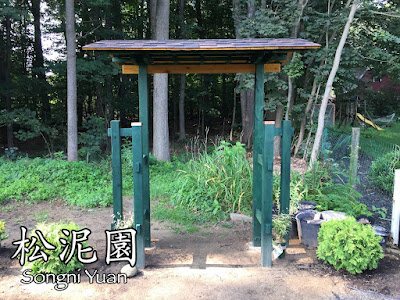As a result of alterations is the Dragon's Spine area, I ended up with a significant number of Hosta segments that needed planting.
 |
| Before Split |
 |
| After Split |
The other three, combined with two other Hostas I had to remove from elsewhere due to overcrowding, needed a new home.
Problem is, I don't really have any place to locate them. I'm afraid to locate them along the back of the wood lot property line because when I do, they get eaten. So, Given that I had five Hosta, each of which had the potential to become a significantly sized plant over the next two years, I decided to place them in the main walkway near the front of the house and the main garden entrance.
There were already two Hosta hear along the edge of the garage, and a Dwarf Korean Azalea (Azalea yedoense 'Poukhanense Compacta') that I had planted last year as an experiment.
I didn't like the way the Azalea was turning out and it was getting crushed by snow from the driveway that piled nearby during the winter. So, I removed it and placed it into a bucket for now.
Placing more Hosta starting at that point and forward towards the large red/square cement pavers made sense for two reasons:
- They would grow enough to cover the line between the driveway surface and the pea stone, reducing the harsh liner break.
- They can be cut back in the fall so that I can continue to dump snow there without damaging a shrub.
To add a termination point, I decided to add two Dwarf Fountain Grass (Pennisetum alopecuroides 'Hameln') plants on either side of the pavers creating an entry way.
Again, the grasses can be cut back before snow falls, allowing me to continue to dump snow here during the winter.
At this point the Hosta seem odd since they are small. But next year they should fill in a bit more, but after two years they should be large enough to bring some balance to all the Hosta.
From a landscape design point of view, this plan is lame - too linear. However, from a budget point of view, it works. The only cost was the two new grass plants and my time/labor. Having a professionally built entryway connecting the garden and front door is a long way off, just too expensive. I have to save my pennies.
In the meantime, my "poor-man's walkway" is sufficient and will look less spartan with these Hosta planted.
Perhaps in the future I can add some hardscape stepping stones or pavers. Until then, looks good to me.




















































